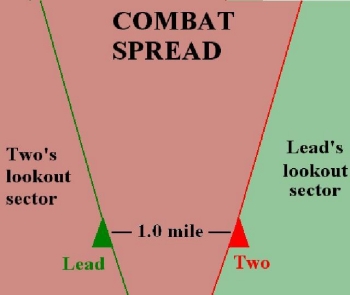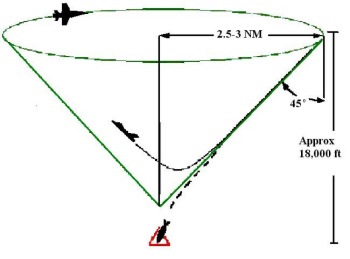Feature: Target Area Mechanics
by John "Zambo" ZambiePage 1
Target Area Mechanics is a way of operating in the air-to-ground target area while maintaining maximum mutual support. I'd like to take this opportunity to describe for you the basics of Target Area Mechanics, but before getting into the details, however, it is important to first understand the concept of Mutual Support and the geometry of the Attack Cone.
Many of you know that most fighters fly in combat spread position most of the time. Combat spread geometry can vary, depending on local SOP, but basically it involves the wingman flying about one mile abeam lead.
COMBAT SPREAD FORMATION AND PRIMARY LOOKOUT RESPONSIBILITIES
In this formation, the wingman looks not just at lead, but also through him in order to acquire any threats approaching from the left. Lead scans through dash two in order to acquire threats coming from the right. It is important for two to be directly abeam lead so that lead doesn't have to look back over his shoulder to see his wingman. The one-mile distance between them exists for two reasons. First, this makes it harder for a bandit to visually acquire both aircraft (especially if dash two is a couple thousand feet above or below lead's altitude). Second, it provides turning room within the section so that if one fighter becomes engaged, his wingman, the free fighter, has room to turn nose on to the fight and prosecute the bandit. This is the basis for what is known as "mutual support", which is a fancy way of saying, "I'll watch your back, and you watch mine." Also note in the example above that dash two also has primary lookout responsibility to the front. This is so that lead can spend more time operating sensors and communicating in order to build his situational awareness.
MEDIUM ALTITUDE ATTACK CONE
The attack cone is an imaginary cone in space above the target. It has a specific radius and dive angle associated with it. The exact dimensions of the cone are determined in pre-mission planning. Although modern jets will automatically compute the trajectory of free-fall ordinance, pilots still strive to be on the briefed attack cone. This is in order to maximize weapon accuracy and minimize the exposure to the threat by arriving at the minimum slant range to the target at which they can release and still pull out of the dive above the threat's maximum effective altitude. Realize that a pilot can roll in on the target from anywhere on the attack cone and achieve these optimum parameters.
© 1997 - 2000 COMBATSIM.COM, Inc. All Rights Reserved.



